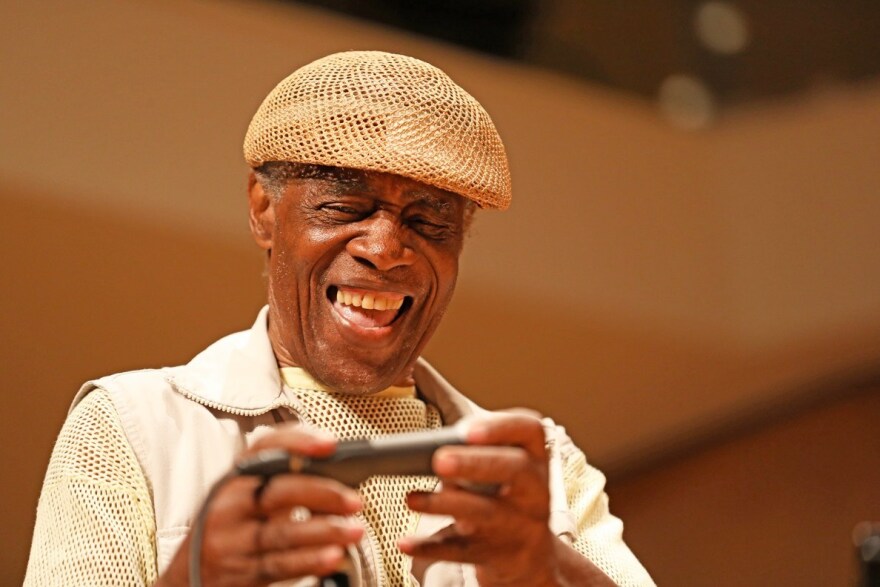Norman Simmons, a pianist, composer, arranger and educator whose multidimensional jazz career featured a series of high-profile associations with singers — like Carmen McRae, Betty Carter, Joe Williams and Anita O’Day — died on Thursday in Mesa, Ariz.
He was 91, and lived in Lakewood, N.J. The cause was multiple myeloma, singer Antoinette Montague, a close friend, tells WBGO.

During a career spanning more than 65 years, Simmons specialized in a precise and nuanced style at the piano, with a keen sense of dynamic variation and harmonic color. For the first half of the 1950s he was a house pianist at the Beehive Lounge in Chicago, backing traveling greats like Wardell Gray and Lester Young. He was part of the band that played with bebop titan Charlie Parker in Feb. 1955, during Parker's final appearance in Chicago.
The strength of Simmons' instincts as an arranger and accompanist, especially but not exclusively behind vocalists, brought him into a rare stratum of musical achievement — but also played a likely role in his chronic undervaluing as a bandleader.
He released fewer than a dozen albums, including several on his own Milljac label. His most recent was In Private, a refined and easygoing trio album made for the Savant label nearly 20 years ago. His earliest was the self-titled Norman Simmons Trio, which the Argo label released in 1956; it features him with bassist Victor Sproles and drummer Vernel Fournier, who would imminently make history on the same label as a member of the Ahmad Jamal Trio. Simmons always maintained that Fournier developed some of his trademark style, including the lilting offbeat bounce of “Poinciana,” in the earlier trio.
But Simmons also credited Jamal as one of his piano influences, along with Oscar Peterson, Duke Ellington and Hank Jones. And like Jones, who devoted a substantial part of his career to backing Ella Fitzgerald, Simmons took pride in his intuition as a singer’s pianist — a skill that kept him in high demand and steady employ for years. It was a singer, Ernestine Anderson, who convinced him to leave Chicago for New York, near the close of the '50s.
Carmen McRae relied on his perceptive support throughout the 1960s and early ’70s, featuring him on albums including Sings Lover Man and Other Billie Holiday Classics and Woman Talk. The depth of their simpatico is perfectly clear on this 1962 performance of Thelonious Monk’s “‘Round Midnight,” taped for Ralph Gleason’s Jazz Casual show. (Sproles is on bass, and Walter Perkins on drums.)
Simmons also found collaborative success with, among others, Betty Carter and Anita O'Day in the 1970s; Helen Humes and Joe Williams in the '80s; Dakota Staton and Etta Jones in the '90s; and Carol Sloane and Mark Murphy in the '00s.
"I accompany most people very well for the simple reason [that] you're doing an instant arrangement," Simmons said in a 1995 interview for the Hamilton College Jazz Archive. "And you’re already deciding where it should go based on what the person is doing. Where to increase the emotion. Where to diminish the emotion. How their breathing is. Where their phrasing is. And you begin to orchestrate accordingly, like that."
Sarney Norman Simmons was born in Chicago on Oct. 6, 1929. As a child he initially learned to play music on his family’s upright player piano; soon he was picking out songs by ear. His most formative influence was Duke Ellington, whom he admired both as a pianist and a composer and arranger. His own output always carried a similar sense of balance, with careful attunement to the personalities of his musical partners.
As a case in point, Simmons served as pianist and musical director of Hyde Park After Dark, a reunion album recorded in 1981 with tenor saxophonists Clifford Jordan and Von Freeman. "I picked up on the way Von expressed himself with a delayed tonguing, whereas Clifford is very straight ahead," Simmons told Aaron Cohen for the liner notes to The Complete Bee Hive Sessions, on Mosaic Records. "Von slingshots his phrases, he holds them back for some period [of] time and then lets them go. Clifford is right on his stuff, because he spent a lot of time in New York."

Simmons taught extensively, with Jazzmobile and at William Paterson and the New School. He was also deeply involved with Jazz House Kids, whose founder and president, Melissa Walker, is another of the singers to have studied and recorded with him. “After I formed the organization in 2012, about two years in, Norman and I used to go into schools in Newark,” Walker tells WBGO. “We had a program called the Vocal Summit, a residency program. And Norman would write all the charts.”
His involvement with Jazz House Kids never flagged, Walker says. “At the end of a recent summer workshop, the applause for him was this resounding standing ovation,” she recalls. “He started to tear up, and he spoke to all of the students at Montclair State University and said, ‘You don’t understand. This music has been my life.’”
She adds: “He was not a person who put himself forward. He put the music forward. He didn’t have another agenda. He was just a vessel for this music.”



